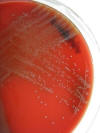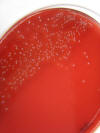General
DEFINITIONS & GLOSSARY
A B C D E F G H I J K L M N O P Q R S T U V W X Y Z
AEROBE/ANAEROBE
- An aerobe is an organism capable of growing in ambient air. An anaerobe is an organism capable of growing in the absence of oxygen.
- Strict or obligate aerobes must have the presence of oxygen to grow while strict or obligate anaerobes must have the absence of oxygen to grow.
- Facultative organisms can grow in the presence or absence of oxygen.
-
Microaerophilic organismsrequire reduced oxygen tension compared to air, this can be achieved by the addition of increased concentrations of CO2 (5%), thus lowering the relative concentration of oxygen. Some organisms do require increased CO2, not just lowering of the oxygen tension. These are known as capnophilic organisms.
AGAR
Agar is a complex polysaccharide derived from red seaweed which is used to solidify media for the growth of micro-organisms. Agar is generally inert and does not provide any nutrients for the organisms. It is highly negatively charged and extensively hydrated, resulting in a gel like structure which solidifies at room temperature. It can be autoclaved without loss of function which is essential for its use in microbiological media. Purified agar is known as agarose and is used in electrophoresis gels. (see medium)
ANTIBIOTIC
Defined as a chemical substance produced by a micro-organism that kills or inhibits the growth of another micro-organism (Madigan and Martinko, Brock’s Biology of Micro-organisms, 11th ed., 2006). Often used synonymously with:
Antimicrobial agent – a chemical that kills or inhibits the growth of micro-organisms.
Note however, that an antimicrobial is any chemical which is capable of killing or inhibiting micro-organisms and does not necessarily have to have been produced by another living organism (i.e. it may be synthetic, and many modern so-called antibiotics are synthetic). The definition would include disinfectants/antiseptics as well as antibiotics. A chemotherapeutic agent is an antimicrobial which can be used internally to treat an infectious disease.
- Broad spectrum antibiotic – one which acts on both gram positive and negative organisms
- Narrow spectrum antibiotic- one which acts on a restricted range of bacteria
ANTISEPTIC
A chemical agent used to kill or inhibit micro-organisms and sufficiently non toxic such that it can be used on living tissue. Generally however, antiseptics cannot be used internally.
CAPSULE
A layer of material external to the cell wall of bacteria and fungi. Usually composed of polysaccharides. Often termed a “slime layer”and may be involved in pathogenesis. Can be visualised using various staining techniques and by negative staining with India Ink
(see Microscopy section).
COLONY
Growth of a mass of micro-organisms from a single progenitor organism on a solid medium. (see morphology)
CONTAMINANT
An organism unrelated to the desired organism present in or on a culture. On agar plates, may have a different colony morphology. Often derived from the environment via fomites (inanimate objects carrying viable organisms, e.g. dust, dead skin cells etc.). Avoiding entry of contaminants into media is the main aim of aseptic technique.
CULTURE
A growth of micro-organisms in or on media, either liquid or solid.
Cultures may be:
- Pure : consisting of only one type of organism
- Mixed : consisting of 2 or more different organisms
To subculture : to take a small portion of a culture and transfer it into or onto a fresh medium.
DISINFECTANT
A chemical used to kill or inhibit micro-organisms on inanimate objects (usually too toxic to be used on living tissues).
FIMBRIA (plural = fimbriae)
Fimbriae are short filamentous structures found in large numbers (up to hundreds) projecting from the surface of bacteria. They are used to attach the bacteria to surfaces and can be considered as virulence factors in some cases where they mediate attachment of the bacteria to host cells. The amino acid sequence of the protein subunits that make up the fimbria gives rise to different types e.g. type IV fimbriae are a common virulence factor for gram negative bacilli such as E. coli.
Fimbriae are not involved in classical motility (this requires flagella, see below) but may be involved in a form called "twitching" motility where the bacteria attach to a surface, flip over and re-attach at a different position, producing the appearance of movement across the surface.
Often the terms pilus and fimbria are used interchangeably but this is not correct. Pili are the filamentous structures used by bacteria during conjugation and transfer of DNA, whereas fimbriae are adhesive structures. Bacteria generally have only 1-2 pili but many fimbriae. See below under pilus.
FLAGELLUM (plural = flagella)
Motile hair like structures on the surface of bacteria used for movement. See also motility. Composed of the protein flagellin. Creates movement by rotation.
HAEMOLYSIS
When grown on blood agar, many bacteria are capable of lysing the red blood cells in the medium. This results in a characteristic zone around the colony, depending on the type of lysis produced. Haemolysis of Streptococci is best shown in sheep blood agar plates but can be seen in other blood agars such as horse blood agar (which is used routinely).
α-haemolysis is an incomplete digestion of the contents of the red blood cells and results in a greening of the agar around the colony. Streptococcus pneumoniae is characteristically α-haemolytic.
β-haemolysis is a complete digestion of the red blood cells and their contents, resulting in a clear zone around the colony. Streptococcus pyogenes (Lancefield group A Streptococcus) is characteristically β-haemolytic.
Some organisms are not haemolytic and this has been termed γ-haemolysis, but the term non-haemolytic is preferable as no haemolysis is actually present.
Alpha (left) and Beta (right) haemolysis on blood agar
An aliquot of organisms added to a growth medium. May be a colony, a part of a colony, a volume of a liquid culture or a clinical specimen. To inoculate means to add the organisms to the medium.
LAG PHASE
Bacterial growth phase which occurs immediately after inoculation of bacteria to a new growth medium. It is the phase where the bacteria are adapting to the new conditions and synthesizing enzymes etc. to deal with the change in environment. After this phase the bacteria enter log phase. (see Microbial Growth chapter)
LOG PHASE
Logarithmic or exponential bacterial growth phase. Cells are dividing at their maximal reproductive capability for the given conditions. After a relatively short time (3-4 hours), nutrients become limited and toxic byproducts accumulate, leading to slowing of growth and entry into stationary phase. (see Microbial Growth chapter)
LYSOGENY
Occurs when the genome of a temperate bacteriophage has integrated into a host bacterial chromosome forming a prophage. The phage genome is replicated along with the host chromosome.
MEDIUM (plural = media)
The nutrient material on or in which micro-organisms are grown. May be liquid (broth) or solid (with the addition of agar). Solid media may be in the form of agar plates (in petri dishes) or in slopes or slants in bottles or tubes.
- Basal : minimum nutrients suitable for non-fastidious organisms. Contains a source of fixed nitrogen (amino acids from peptone or tryptone), a carbon and energy source such as glucose and mineral salts. Examples include nutrient broth and nutrient agar.
- Enriched : as above plus additional nutrients, often in the form of natural substances such as blood or yeast extract. Suitable for more fastidious organisms. Examples include blood agar and chocolate agar.
- Selective : media with the addition of substances which only allow the growth of certain organisms. Selective agents include antibiotics, bile salts, selectively toxic dyes, heavy metals etc. Examples include Rappaport broth and tellurite agar.
- Differential : media which allow the growth of different types of bacteria where each type has a different appearance. Examples include MacConkey agars, which are both selective and differential.
METACHROMATIC GRANULES
Granules of polyphosphate found as a storage substance in certain bacteria, notably in Corynebacterium diphtheriae and some Mycobacteria. Also known as volutin granules. Stained with methylene blue in Albert’s technique due to the multiple negative charges on the phosphates (metachromasia).
MOTILITY
The ability of organisms to move relative to other organisms and structures and independent of factors in the environment i.e. against the flow of a fluid. For bacteria, motility is due to the presence of flagella (singular = flagellum). Motility can be directly observed in liquid cultures via the hanging drop method (see Microscopy) or in semi-solid motility agar (see Media).
- Monotrichous – having one flagellum (usually polar)
- Peritrichous – many flagella around the entire bacterium
- Lophotrichous (polar) – many flagella at one end of the bacterium
- Amphitrichous – one flagellum at each end of the bacterium
PILUS (plural = pili)
Filamentous protein appendages arrayed perpendicular to the surface of bacteria and projecting out into the extracellular space. They are used to attach bacteria to other bacteria and are not involved in classical motility. A pilus is composed of subunits of the protein pilin. Long conjugation pili are also known as F pili (also called sex pili).
Long pili are found in low numbers on bacteria and used to attach one bacterium to another, typically of the same species. They are involved in the process called conjugation, where plasmids are transferred from one cell to another. These plasmids code for the expression of F pili in the donor cell.
STATIONARY PHASE
Bacterial growth phase where the number of cells dividing is balanced by the numbers dying such that the total cell count may increase but the viable cell count remains the same over time. (see Microbial growth chapter)
VIABLE COUNT
The number of bacteria in a culture which are alive and capable of dividing. Not necessarily equivalent to the total numbers in a culture which includes live and dead organisms. See chapter on Microbial Growth for methods of performing a viable count.

